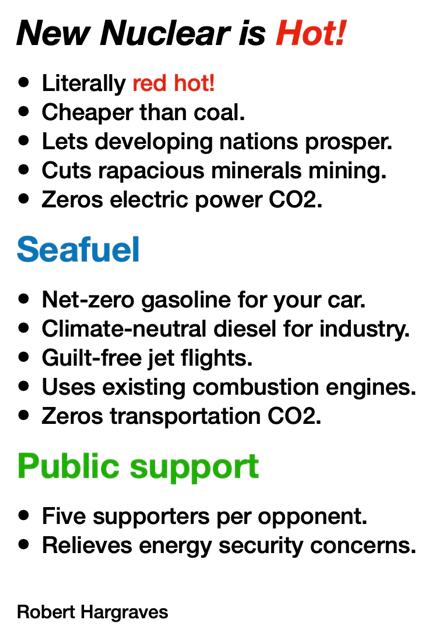The drumbeat for more nuclear power grows louder all the time.
As the demand for more electricity rises inexorably (now agreed at 2 percent a year nationally and more in specific areas), the case for a surge in nuclear power plant development becomes stronger. With their intermittency, solar and wind can’t accommodate the growth alone.
Polls show that public support for nuclear power in the United States is around 60 percent. Environmentalists who once opposed nuclear now endorse it.
Every day, in newspapers and places where opinions are heard, experts claim that the world can’t reach its climate goals without nuclear energy. For the United States, that seems clear. The prognosticators in and out of government say it is so.
There is political support in both parties, and nuclear has been on a technological march: better safety, better fuel, less steel and concrete.
A platoon of small modular reactors (SMRs) — which generate 400 megawatts or less of electricity compared to the plants currently operating, which are primarily over 1,000 MW — is in the wings.
The argument for these SMRs has been that because they are smaller, they will be cheaper to build, with much of the fabrication done in a factory, and easier to site.
The first of the breed is from NuScale, which has been under development for more than a decade but recently lost its first U.S. customer, Utah Associated Municipal Power System, because of the rising projected cost of electricity from the plant.
A lot of interest is focused on the Natrium reactor, which is planned for a former coal-fired plant site in Wyoming and backed in part by Bill Gates and with participation from GE Hitachi.
Several utilities are looking at other designs. Of these, only NuScale uses a modified light water system, the technology on which the world’s 400-plus power-generating reactors have been based.
The case for new technologies is eloquently made in a new and extraordinarily complete but very accessible book, “New Nuclear Is Hot,” by longtime nuclear advocate Robert Hargraves, a physicist.
Hargraves’ argument is that the alternative technologies now under development are hotter: They operate at far higher temperatures than the old reactors and are better for industrial uses; more of the heat is converted to electricity, less is wasted on disposing of so-called low-grade heat, and the plants are smaller, easier to build and are inherently safer.
It is a convincing list of virtues.
Hargraves says, “New nuclear reactors exploit hotter heat in fluids such as molten salts, liquid sodium, or helium gas. The red-hot temperature heat puts 50 percent more of the reactor’s fission energy into electrical energy, not into the cooling water that condenses turbine-generator steam. Waterside new nuclear power plants use about half of the cooling water of current ones.”
Additionally, Hargraves says, “Hot heat also brings new uses. Hot heat can break hydrogen out of seawater cheaply, heat buildings, power electrochemical separators to capture (carbon dioxide), and energize new refineries to produce net zero fuels from the (carbon dioxide) and hydrogen.”
Hargraves is a promoter of thorium reactors and is one of the founders of ThorCon, a company that hopes to build a thorium reactor in Indonesia.
However, the underlying challenge to nuclear energy and providing the nation with enough electricity, as it converts to an electric economy, isn’t technology but money. First-of-its-kind reactors are expensive.
Even tried-and-true light water reactors are tricky to build. The two new units of the Vogtle plant in Georgia came in $17 billion over budget and seven years late. The story for the latest reactor built in Finland has been similar: cost overruns and delays.
New reactors are expensive, and that expense is hard to estimate. That means if the nation wants electricity, it needs to think up ways of financing the new future of nuclear power outside of the traditional avenues of finance. A nuclear plant can last for 100 years or more, but the big hurdle is the billions of dollars required upfront.
It becomes a national survival issue: Will the nation have enough electricity for the future, or will it accept electricity shortages as a limiting factor in the economy?
The nuclear establishment doesn’t need more endorsements. It needs to lay out a plan for not what should be built but how it will be paid for — and it requires that plan now.

